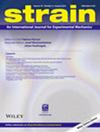材料微观结构大CT数据的三维光流
IF 1.8
3区 材料科学
Q2 MATERIALS SCIENCE, CHARACTERIZATION & TESTING
引用次数: 3
摘要
我们计算三维位移矢量场来估计力学测试中微观结构数据集的变形。为此,我们将Brox等人的众所周知的光流扩展到三维,特别关注非线性项的离散化。我们首先通过综合变形泡沫并与此基础事实进行比较来评估我们的方法,然后与经过真实机械测试的样本数据集进行比较。我们的结果与材料科学和医学图像配准中最先进的算法进行了比较。通过全面的评估,我们表明,我们所提出的方法能够最好地解决位移在所有选择的比较方法。本文章由计算机程序翻译,如有差异,请以英文原文为准。
3D optical flow for large CT data of materials microstructures
We compute three‐dimensional displacement vector fields to estimate the deformation of microstructural data sets in mechanical tests. For this, we extend the well‐known optical flow by Brox et al. to three dimensions, with special focus on the discretization of nonlinear terms. We evaluate our method first by synthetically deforming foams and comparing against this ground truth and second with data sets of samples that underwent real mechanical tests. Our results are compared to those from state‐of‐the‐art algorithms in materials science and medical image registration. By a thorough evaluation, we show that our proposed method is able to resolve the displacement best among all chosen comparison methods.
求助全文
通过发布文献求助,成功后即可免费获取论文全文。
去求助
来源期刊

Strain
工程技术-材料科学:表征与测试
CiteScore
4.10
自引率
4.80%
发文量
27
期刊介绍:
Strain is an international journal that contains contributions from leading-edge research on the measurement of the mechanical behaviour of structures and systems. Strain only accepts contributions with sufficient novelty in the design, implementation, and/or validation of experimental methodologies to characterize materials, structures, and systems; i.e. contributions that are limited to the application of established methodologies are outside of the scope of the journal. The journal includes papers from all engineering disciplines that deal with material behaviour and degradation under load, structural design and measurement techniques. Although the thrust of the journal is experimental, numerical simulations and validation are included in the coverage.
Strain welcomes papers that deal with novel work in the following areas:
experimental techniques
non-destructive evaluation techniques
numerical analysis, simulation and validation
residual stress measurement techniques
design of composite structures and components
impact behaviour of materials and structures
signal and image processing
transducer and sensor design
structural health monitoring
biomechanics
extreme environment
micro- and nano-scale testing method.
 求助内容:
求助内容: 应助结果提醒方式:
应助结果提醒方式:


